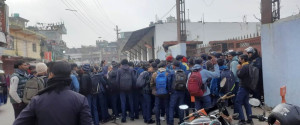National
60 percent of jar water samples collected from Godawari found contaminated with faecal coliform
Hospitals in the Valley report a surge in diarrhoea, viral hepatitis, and viral fever cases.
Post Report
Sixty percent of the samples of jar water collected from various locations in the Godawari Municipality of Lalitpur district have been found contaminated with faecal coliform.
Of the 10 samples of 10 separate bottled water companies collected by health workers deployed from the municipality, which were tested in the laboratory of the Health Office Lalitpur, six tested positive for microbes.
“We have sealed the factories that were supplying contaminated water,” said Muna Adhikari, Deputy Mayor of the municipality. “We will also check the quality of drinking water being piped to households by water supply utilities, and this is just the beginning.”
Faecal coliform, a microscopic organism, lives in the intestines of warm-blooded animals or their faeces. The presence of faecal coliform means the jar water, being used by locals of the municipality, is contaminated with sewage, doctors say.
Jar water is considered safer for drinking compared to the water piped to household taps. However, the detection of deadly bacteria in jar water samples indicates that the water of most jar companies is not safe for drinking, and one needs to ensure that the water is safe before drinking, according to them.
Adhikari said that a quality inspection of the jar water was carried out, as per the locals' complaint.
“We will let the companies resume production only after they prove overall improvement in quality,” said Rewati Karki, chief of the health section at the municipality. “We will again check the quality of water samples and decide whether to give permission for resuming production.”
Drinking water contamination is not new in Kathmandu Valley, especially during the monsoon season, when most drinking water sources are contaminated with rainwater. Every year, thousands of people get infected with water-borne diseases—dysentery, typhoid, and hepatitis A and E and deadly cholera.
Also, last year, faecal coliform was detected in a study of water samples collected from Godawari Municipality. Several people in the municipality were infected with deadly cholera.
Vibrio cholera 01 Ogawa serotype had been confirmed in the stool sample of an infected patient at the time.
Cholera is a highly infectious disease that causes severe diarrhoea and vomiting, which in turn results in dehydration and can lead to death within a few hours if left untreated. The World Health Organisation says cholera is a global threat to public health and an indicator of inequality and a lack of social development.
Meanwhile, hospitals in the Kathmandu Valley have reported a surge in cases of water-borne diseases, including diarrhoea, viral fever and viral hepatitis.
The Kanti Children’s Hospital, which treats over one thousand patients daily, said that over 60 seriously ailing diarrheal patients seek care at the hospital every day.
“Along with diarrheal patients, the number of patients suffering from viral hepatitis has also surged in our hospital,” said Dr Sumit Agrawal, spokesperson of the hospital. “A lot of children are getting infected with diarrheal problems every day, which indicates that the food and drinking water they are using are not safe. Parents must take precautions for safety.”
Viral hepatitis is a viral infection that causes inflammation of the liver. Doctors say consumption of food or water contaminated with the hepatitis virus causes the disease.
The Sukraraj Tropical and Infectious Disease Hospital has also reported a surge in cases of diarrhoea and viral fever.
“The number of patients suffering from diarrheal diseases and viral fever has risen in our hospital in recent days,” said Dr Yuba Nidhi Basaula, director at the hospital. “We anticipate a further surge in such cases in the coming days, as most of the water sources have been contaminated with rainwater.”
The monsoon is an epidemic season in Nepal, during which most sources of drinking water are contaminated with deadly microbes—E coli and faecal coliform—and thousands of people from across the country become infected with water-borne and vector-borne diseases.
Public health experts have urged authorities to launch an awareness drive about the risks and take measures to ensure the supply of safe drinking water to households.




 5.47°C Kathmandu
5.47°C Kathmandu







%20(1).jpg&w=300&height=200)





